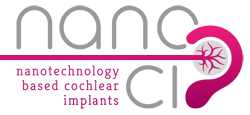The concept of NANOCI

It is generally acknowledged that eliminating the gap between neurons and the electrode array and hence increasing the number of active channels should greatly improve the effectiveness of auditory nerve stimulation. The NANOCI project therefore aimed to attract the peripheral processes of the auditory nerve towards the electrode array.
NANOCI worked on the development of a neuroprosthesis with a gapless interface to auditory nerve fibres. An innovative, nanomatrix containing diffusible and surface-bound neurotrophic compounds was used with the idea to attract and guide the neurites towards the functionalized, neurotrophic electrode array surface. To achieve a long-lasting operation without interface degradation, reduced biofouling and improved conductivity, several approaches for nanostructuring of the array surface were devised. Various functional nanomaterials, including carbon nanotubes, were used in concert with structuring methods such as ion implantation and sacrificial nanoparticle embedding in parylene, SOLID (solid on liquid deposition) encapsulation, and sonochemistry. Components were validated using appropriate bioassays including human auditory neurons in vitro. In parallel, software models were developed to exploit the enhanced effectiveness of the bidirectional, gapless interface. By combining all these developments, an animal-grade, pilot nanoCI-device has been manufactured and tested in vivo. This allowed to assess the feasibility of a future, cost-efficient, and fully implantable neuroprosthesis with substantially increased sound quality.
The NANOCI concept is illustrated in the slideshow below.
In summary, the current literature supports the assumption that mature auditory neurons are capable of sprouting towards a neurotrophin source located in the scala tympani, particularly in presence of electrical stimulation.
Novel solutions have to be developed to guide the neurons through the perilymph fluids of the scala tympani and to permanently lock them on the surface of the array.
For long-lasting restoration of the hearing function, biocompatibility, biosafety and antibiofouling activity of such an implant have to be guaranteed.
To optimally exploit the potential of a gapless interface through the associated increase in channel numbers and to capitalize on the simultaneous stimulation/recording of smaller neuronal populations, novel coding and signal shaping strategies will be required.
